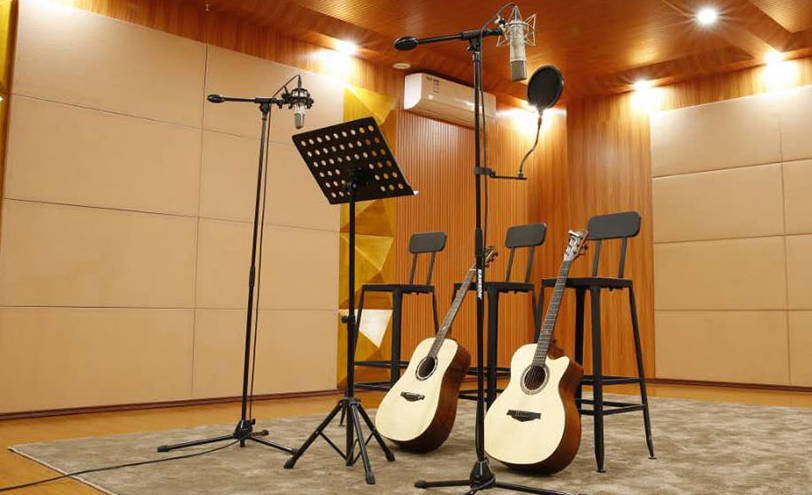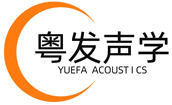notice:
Search:
Code for acoustic design of recording studio buildings

admin
Acoustic PET Felt Panels Factory | Akupanel & Acoustic Wall Panels Manufacturer - Guangdong Yuefa Acoustic New Materials Co., Ltd
Performing arts buildings include various types of cinemas, theaters, theaters, audio-visual rooms, exhibition rooms, studios, recording rooms, and other multi-purpose hall buildings.
With the rapid development of the economy and the continuous improvement of people's living standards, after meeting the basic guarantee of material life, people begin to pursue spiritual sustenance and aesthetic pleasure, which is called spiritual life. In the continuous progress of society, more and more middle and upper class members are emerging, many of whom belong to the group pursuing high-quality consumption. The development of performing arts architecture has enabled a large number of social groups to relax and enjoy themselves in today's fast-paced and high-pressure society.
To build a comfortable performing arts building environment, not only does it require a grand or gorgeous appearance, but also the indoor acoustic environment must be considered. The scope of performing arts architecture is relatively broad. Below, we will analyze the acoustic design of some of the main venues.

1、 Introduction to Sound Studio in Architectural Acoustic Design of Recording Studio
A recording studio, also known as a recording studio, is a specialized recording venue built by people to create specific acoustic conditions for recording. It is a recording venue for movies, songs, music, etc. The acoustic characteristics of a recording studio play a very important role in the quality of recording production and its products. People can classify it according to their needs, for example, according to the basic characteristics of the sound field, it can be divided into natural reverberation recording studios, strong absorption (short reverberation) recording studios, and active quiet end (LEDE) recording studios. It can also be divided into white recording studios, music recording studios, sound recording studios, mixed recording studios, and so on from a usage perspective.
2、 Technical specifications for acoustic design of recording studio buildings
The acoustic design specifications require that the sound quality of the recording studio should mainly be "high language clarity and intelligibility, followed by good fullness". Under the main usage conditions, it should have corresponding reverberation time and frequency characteristics to the pickup requirements, and suppress sound defects that affect the pickup audio, such as echoes, trembling echoes, low-frequency buzzing, etc. According to the above requirements; The design standards for the recording studio are:
The recording studio uses short reverberation, and the appropriate reverberation time should be selected based on the indoor volume. The frequency characteristics of the reverberation time should be flat. Acoustic technical indicators:
Recording room acoustic indicators

3、 Treatment of acoustic defects in the acoustic design of recording studio buildings
1. Noise generation
The noise in the recording studio comes from multiple sources. The noise from outside the recording studio can be mainly divided into two categories: one is the traffic noise generated by passing vehicles, airplanes, etc. outside the recording studio building; Another type of noise comes from inside buildings but outside the recording studio, such as loud conversations and noise during commuting; There is also internal noise from the recording studio, mainly from the air conditioning system, lighting control system, and the movement noise of the camera and the walking noise of the staff during the operation of the recording studio.
2. The propagation of noise
Noise enters the recording studio mainly through three ways. Firstly, noise acts on walls, floors, and ceilings, causing vibration and radiating sound energy into the recording studio; The second is to transmit sound into the recording studio through air through gaps and unsealed holes left during construction; The third is to enter the recording studio through solid sound transmission through the rigid connection between the wall, roof, or ground of the recording studio and the outside world.
3. Noise control
The sound insulation problem of the recording studio mainly involves the surrounding walls, windows, and entrance and exit doors.
The following methods are mainly used for sound insulation of the above issues:
Mainly lies in the use of multi material composite sound insulation walls with different sound insulation levels (multi damping lightweight wall sound insulation) and external window sealing, which can basically isolate the impact of external noise on the recording studio; The entrance and exit doors should use composite material national standard soundproof doors.

Hot products
-
Micro Perforated Wood Acoustic Panel
The materials of Micro Perforated Wood Acoustic Panels are made of MDF with microperforations on the visible side and big holes in the back side.
-
Wall And Ceiling Acoustic Perforated Wood Panels
Premium grade perforated wood acoustic panels for wall and ceiling applications. Achieve 0.90 NRC with Class A fire-rated natural wood panels. Custom patterns & finishes for architectural acoustics.
-
Standard 9 mm PET Felt panels
Discover customizable acoustic wall panels made from 100% recycled PET polyester fiber. Achieve NRC 0.85+ sound absorption with eco-safe (12 bottles recycled/panel), fire-resistant (Class A/B1) solutions. Perfect for studios, offices & modern interiors. Custom sizes/colors available. LEED & GREENGUARD Gold certified.
-
Smoked oak sound-absorbing board, black felt
As a leading Chinese acoustic panel manufacturer, our factory specializes in producing Akupanel wooden slat acoustic panels that combine aesthetic appeal with superior noise reduction performance. These wood wall acoustic panels are ISO 9001 certified, featuring Class A fire ratings and NRC 0.85 sound absorption coefficients.
-
Wooden Grooved Wall Panels
China's Leading Wooden Grooved Wall Panels Manufacturer - Get premium quality acoustic wood slat panels at factory-direct prices. Our FSC-certified grooved wall panels feature custom CNC designs (5-20mm depth), excellent sound absorption (NRC 0.6-0.9), and 12+ finish options. Ideal for commercial spaces, residential interiors, and acoustic treatment. ISO 9001 certified with 15+ years experience. MOQ 100㎡ with free samples available. OEM/ODM services supported. Contact us today for wholesale pricing from China's trusted wood wall panel supplier!
-
24mm PET Acoustic Panels Polyester Fiber Sound Absorbing Material
Our 24mm PET Acoustic Panel answers your acoustical and aesthetic needs with its strong sound-absorbing performance, durability, and elegant appearance. These panels are used for sound reduction and reverberation control. Available in a wide variety of sizes, thicknesses, fabric styles, and colors. 24mm PET Acoustic Panels allow you to create an effective sound control treatment that is distinctly appropriate for your environment.
-
Polyester Acoustic Panel (standard)
High-performance polyester fiber acoustic panels for noise control and sound absorption. Eco-friendly soundproofing solution for commercial and residential spaces with Class A fire rating.
-
300x300mm Hexagon Wall Panels - Soundproof Polyester Fiber Acoustic Panels for Easy Installation
Upgrade your space with our 300x300mm hexagon acoustic panels. Made from high-density polyester fiber, these soundproof wall panels effectively reduce noise and echo. Quick installation, stylish design, and premium sound absorption for offices, studios, and homes.
-
Perforated Wood Acoustic Panel
Product introduction: Acoustic Wood panels is a sound-absorbing material of MDF material with many holes. It is widely used in theater, restaurant, household and other places which need to reduce noise. DIY Perforated Acoustic Panel Precautions: l Wood or melamine veneer with different colors is natural phenomenon. l Pay attention to moisture before installation. Please keep them in a dry environment.
-
Waterproof PVC Sound Barriers
Our sound insulation products help protect and reduce the impact of industrial noise on surrounding residents and on-site workers.We use the world's leading acoustic technology and innovative material design to provide the most effective temporary sound solutions on the market.The one of most important thing is that soundproof products can work under various conditions on any construction site.
-
Premium Decorative Natural Grooved Akupanel Wooden Acoustic Panels – Direct from China Manufacturer
As a leading China-based acoustic panel factory, we specialize in crafting high-quality Decorative Natural Grooved Akupanel Wooden Acoustic Wall Panels that combine aesthetic appeal with superior sound absorption. Our products are engineered for architects, interior designers, and contractors seeking eco-friendly acoustic solutions with customizable designs.
-
Private Soundproof Pod Booth For Office
Flexible and movable soundproof booth.the interior is equipped with polyester fiber sound-absorbing panels. It has the advantages of fire prevention, safety and stability.
-
Modern Office Meeting Pods - 2 Steel Walls + 2 Glass Walls - Custom Sizes Available
China factory-direct manufacturer of premium soundproof meeting pods featuring 2 metal walls + 2 glass walls. Our ISO-certified office pods deliver 38dB noise reduction with quick-ship modular designs. Custom sizes/colors available with 5-year warranty. Ideal for offices, coworking spaces & universities. Competitive pricing with bulk order discounts. Request CAD files & quotes today!
-
Wholesale Anti-Vibration Pads
Source high-quality wholesale anti-vibration pads for machinery, construction, and OEM projects. Get competitive bulk pricing, global shipping, and custom solutions from trusted suppliers.
-
20mm polyster fiber panel directly supplied by Chinese manufacturers
PET Acoustic Panel is made from 100% polyester,by needle punching processing. The production processis completely physical&eco-friendly, no waste water,emissions, waste. no adhesive, The porous nature ofacoustic panel makes it sound absorptive&thermalinsulative.
-
Sound Insulation Wood Wool Acoustic Panel
Wood fiber acoustic board is a decoration and sound insulation material, using pure wood wool as raw material which is characterized by available for a variety of colors and patterns to choose from, the finishes color can be adjusted according to the requirements of the acoustic renovation or investors; wool wood acoustic panel sound absorption spectrum is high, which have fairly good results for low, medium and high frequency noises, and good fire-proof, no dust pollution, strong decorative and simple to use. There are many specification levels available for investors to choose, you can simply note when ordering.
Cases
-
Acoustic Decoration Project for Lecture Hall - Nanhai Middle School Renovation and Expansion Project
The original acoustic design of the auditorium at Nanhai Middle School can no longer meet the needs of modern teaching and activities, especially in large-scale lectures, conferences, and cultural events. The uniformity of the sound field and the clarity of speech directly affect the efficiency of information transmission and learning outcomes. Therefore, carrying out scientific and reasonable acoustic decoration is the top priority of current work.
-
Shenzhen Longhua Experimental School Concert Hall
Shenzhen Longhua Experimental School Concert Hall
-
Acoustic Decoration Project of Guangzhou Metro Museum
Acoustic Decoration Project of Guangzhou Metro Museum
-
Acoustic Renovation Case of Lecture Hall (Dongguan Songshan Lake School Junior High School Project) - Yuefa Acoustics
The lecture hall is not only used for hosting large-scale conferences, cultural performances, and social events, but also often serves multiple functions such as education and training, exhibitions, etc. The goal of acoustic renovation is to optimize the sound field distribution, reduce noise interference, and improve audio clarity, so that the auditorium can better adapt to various needs.
-
Nanhai Middle School Lecture Hall
The original acoustic design of the auditorium at Nanhai Middle School can no longer meet the needs of modern teaching and activities, especially in large-scale lectures, conferences, and cultural events. The uniformity of the sound field and the clarity of speech directly affect the efficiency of information transmission and learning outcomes. Therefore, carrying out scientific and reasonable acoustic decoration is the top priority of current work.
-
Acoustic architectural decoration of the multifunctional hall at Xinyu Ninth Middle School
Yuefa Acoustics provides professional multifunctional hall acoustic decoration design solutions, including architectural acoustics, sound reinforcement, and noise control design, with the aim of ensuring language clarity in the audience seats.
-
Songshan Lake Taiwan Garden North School - Classroom Acoustic Decoration Project
In the current educational environment, the acoustic design and decoration of classrooms are receiving increasing attention. A good acoustic environment can not only improve students' learning efficiency, but also provide teachers with a better teaching space. As a modern educational institution, Songshan Lake Taiwan Garden North School has realized this and therefore carried out classroom acoustic decoration projects in order to create an ideal learning and teaching environment for teachers and students.
Online Service



